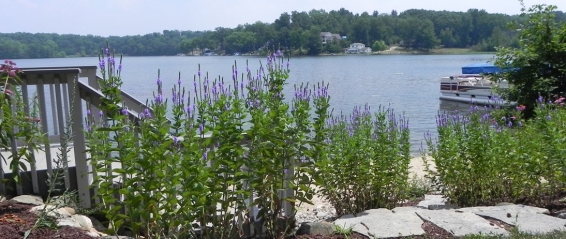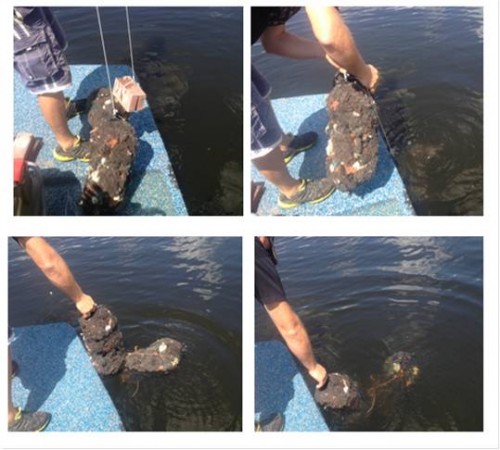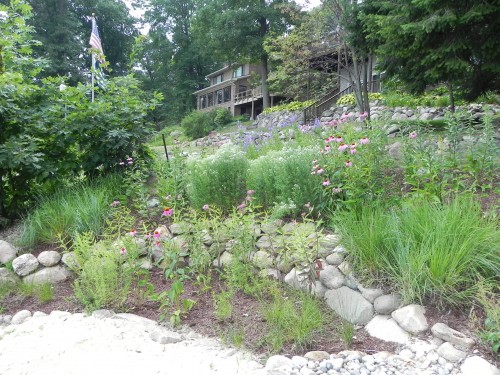Nutrient Filtration: Protect Your Lake from Incoming Pollutants
Protect your lake from incoming pollutants NOW!
In a perfect world pollution wouldn’t enter the lake in the first place. In the real world it has proven nearly impossible to stop. Watershed Management has been the “official policy” for lake restoration for decades. Despite decades of emphasis and spending on watershed management, freshwater ecosystems (lakes, ponds, rivers and streams) are in worse shape than ever.
The answer is NOT to abandon watershed management, but not rely on it to save your lake. At Lake Savers, we won’t accept the status quo when it comes to stopping nutrient pollution from entering our lakes. Recognizing that traditional watershed management can be difficult and prohibitively expensive, we’ve developed our own approach.
This approach combines a revolutionary new technology for filtering pollutants before they can do damage to the lake, and a set of common-sense best management practices that any lake community can implement immediately with a bit of grit and determination.
We’ve discovered that implementing Lake Coral Technology combined with some simple, practical steps in the immediate watershed around the lake can make all the difference.
We’re are not suggesting that you abandon comprehensive watershed management efforts. In fact, we will help you work with local, state and federal agencies to advocate for your lake and watershed. It is all part of our long-term community engagement commitment and process. We leave no stone unturned. Our commitment is simply to save lakes…whatever it takes.
Lake Savers Lake Coral: Game Changing Nutrient Filtration Technology
Lake Coral is a new and game-changing technology. Developed in partnership with Floating Islands International, Lake Coral was designed specifically to capitalize on our Lake Bottom Aeration and Bio-Augmentation technology for the purpose of rapidly accelerating nutrient reduction. Similar to ocean dwelling coral reefs, artificially constructed Lake Coral:
- Acts as a nutrient filter.
- Accelerates the growth of aerobic bacteria in the water column which divert nutrients into food for fish instead of weeds, algae and muck.
- Provides sustainable habitat for Periphyton, diatoms, and other beneficial microorganisms such as phytoplankton, zooplankton, and insects – all of which are critical for continual fish growth.
- Dramatically increases biodiversity and water quality.
Best of all – it can be installed in a matter of minutes and is a very cost-effective restorative technology.
Securely anchored just below the surface of the lake, each unit weighs 4 lbs. Units can be joined together in any configuration to meet the specific filtering needs of any lake.
Each pound of Lake Coral provides 170 square feet of wetland filtration surface area. Putting 250 lbs of Lake Coral into a water body is the equivalent of building a 1 acre wetland filtration area for the lake.
The lake coral matrix provides a large surface area for biofilm growth which becomes a living nutrient filtration “reactor” in the lake. The microbes and phytoplankton uptake nutrients and move them into and through the food chain. Suspended organic particles stick to the biofilm and become periphyton, food for scuds, nymphs and ultimately fish. Suspended inorganic solids such as heavy metals in particulate form, slough off and settle in the benthic zone beneath the island. The coral is a sink for carbon dioxide and enables nitrates and ammonia to be removed from the water and safely converted back to nitrogen gas. This process prevents or slows down eutrophication and keeps the aquatic system in balance.
Nutrient Filtration = Surface Area + Circulation + Dissolved Oxygen
However, as with all life forms, microbes are limited by certain primary variables, which, in this case, are surface area and circulation. Forced circulation of oxygenated water through the lake coral matrix to gain maximum contact with biofilm has been shown to increase the effectiveness of the lake coral up to 500 percent. This is why we combine Lake Coral Technology with Lake Bottom Aeration to deliver the maximum nutrient filtration capability possible.
Common Sense Watershed Management Practices
Five things you can do to make an immediate difference:
1. Eliminate the Use of Lawn and Garden Fertilizers
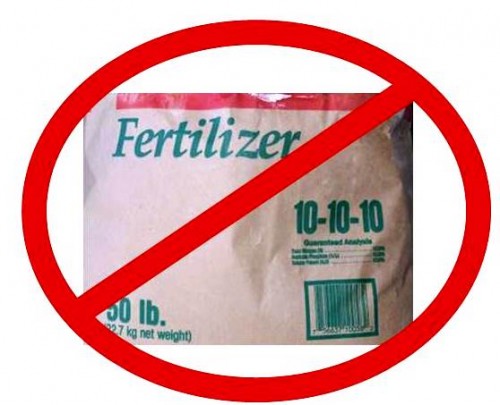 Green Lawns = Green Lakes! Lawn and garden fertilizers are also lake weed and algae fertilizers. In particular, phosphorus is like JUNK FOOD for lake weeds and algae. Just one pound of phosphorus can produce 10,000 pounds of wet weeds and algae! Phosphorus is the “middle” number listed on lawn and garden fertilizers. The best option is no fertilizer usage within 400 feet of the lake or zero phosphorous fertilizers. Major lawn and garden stores should carry zero phosphorus fertilizers. However, EVEN zero phosphorus fertilizers contain other nutrients like nitrogen that are bad for the lake. In many lakes, adding nitrogen will result in algal blooms even without the addition of more phosphorus.
Green Lawns = Green Lakes! Lawn and garden fertilizers are also lake weed and algae fertilizers. In particular, phosphorus is like JUNK FOOD for lake weeds and algae. Just one pound of phosphorus can produce 10,000 pounds of wet weeds and algae! Phosphorus is the “middle” number listed on lawn and garden fertilizers. The best option is no fertilizer usage within 400 feet of the lake or zero phosphorous fertilizers. Major lawn and garden stores should carry zero phosphorus fertilizers. However, EVEN zero phosphorus fertilizers contain other nutrients like nitrogen that are bad for the lake. In many lakes, adding nitrogen will result in algal blooms even without the addition of more phosphorus.
The best alternative of all is to use an irrigation pump and use lake water to water and feed your lawn and garden. The lake water will provide your lawn and garden with all the nutrients needed while taking phosphorous and other nutrients out of the lake!
2. Keep Leaves and Clippings Out of The Lake
It goes without saying that we can’t prevent leaves from falling into the lake. However, we certainly don’t want to make the problem worse by dumping leaves or lawn clippings into the lake. As a lake property owner, you can make a contribution by dumping leaves and lawn clippings at least 400 feet from the lake and by removing branches, leaves and weeds from your shoreline and swimming areas. Also, do not burn leaves and brush within 400 feet of the lake. The ash contains high concentrations of phosphorus. If washed into the lake by a heavy rain, it is like dumping fertilizer right into the lake!
3. Keep Your Septic System Maintained.
Keeping your septic system in good order is critical to improving water quality. Therefore, it is in everyone’s best interest – especially the lake’s – to keep septic systems in good working order to prevent seepage from entering the watershed.
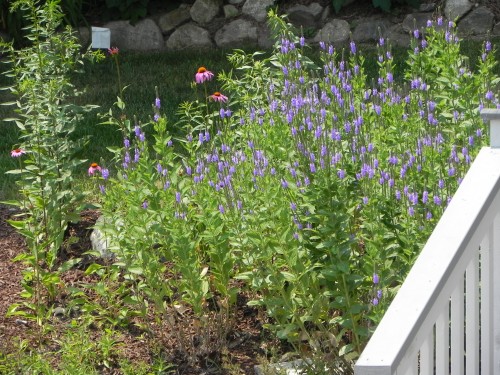 4. Redesign Your Landscaping and Improve Your Shoreline and Swimming Areas
4. Redesign Your Landscaping and Improve Your Shoreline and Swimming Areas
If you are planning major landscape or sea wall changes, consider developing a “lake friendly” landscape and sea wall plan. Lake friendly design features include reducing the amount of lawn area, planting “buffer zones” along the shoreline and “water gardens” to catch heavy runoff from roofs, driveways and steep slopes. If you would like assistance in developing your site plan contact us and we will help you find the information and expertise you need.
5. Get Involved!
As you take care of the immediate “lake-shed” area, then go to work on the larger watershed. Form working groups to educate and pressure local officials to do more, apply for grants, and advocate for broad watershed improvements. At Lake Savers, our commitment extends beyond fixing the lake to engaging the community in an on-going process to sustain the health of your lake. Contact us if you would like additional information and assistance at info@lake-savers.com
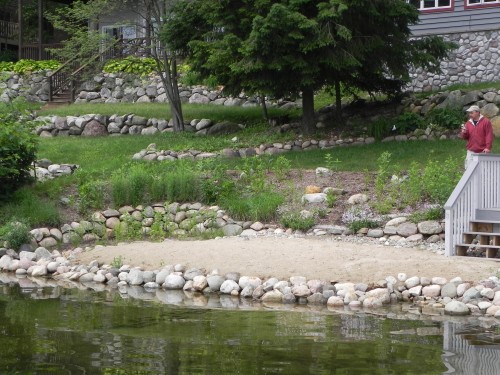 More on Restorative Shores Landscape Techniques
More on Restorative Shores Landscape Techniques
Does your shoreline landscaping prevent or promote fertilizers entering the lake from your property? Taking responsibility for the health of a lake starts with lake-front property owners keeping fertilizers and other chemicals from entering the lake via their property’s watershed.
There are some simple, highly effective landscaping techniques that:
- Keep your property from being part of the problem of nutrient overloading…
- Turn your shoreline into a natural nutrient filter…
- Provide a habitat for fish and other aquatic life forms.
- Use natural rock “rip rap” for your sea wall versus concrete. This provides more natural habitat for shoreline plants and critters and does a better job of preventing “gauging” of the lake-bottom from wave action.
- If you want a beach area, build a “perched beach” that raises the beach area above the high-water mark and prevents sand from washing into the lake.
- Use native, drought resistant plants that have deep roots for holding soils in place and filter lots of nutrients during rain events.
When one shoreline is restored, others will follow. It’s a personal commitment to lake restoration with a huge lake & community return. It’s a concrete contribution to the long-term health of your lake. If you decide to turn your shoreline property into a watershed filtering landscape – we can help. Contact us at info@lake-savers.com.



